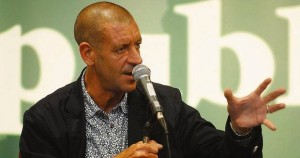Professor Diarmaid Ferriter’s research into sexuality, as he informed the Central Library audience who attended his Heritage Week lecture, raised an interesting question: “Whether or not there was a distinct national sexual history or sexual story.” This issue has been raised by historians of differing nationalities, perhaps most prominently by French philosopher Michel Foucault (1926-84), who focused, as Prof Ferriter put it, on “the idea of control and power”. He stated: “What Foucault suggested was that the management of sexuality was the most subtle and far reaching form of discipline and control in a variety of different countries. And it’s a reminder, of course, that Ireland is not unique; perhaps we have a tendency to exaggerate our exceptionalism when it comes to our experience of these matters.”

Ninety minutes in the company of Professor Diarmaid Ferriter at Waterford's Central Library proved time well spent
But this hasn’t stopped Prof Ferriter from making the case for aspects of a distinct Irish sexual identity, “some of which had to do with social forces, some of which had to do with religious forces but we do need to place these things in a wider context. The whole idea, for example, of moral panics was one that was common to many countries: there were moral panics in Ireland, particularly in the 1920s just as there moral panics in Germany and in France, in the United Kingdom and in Australia during that same period, with a different emphasis, perhaps, in different countries, but they did share that idea of an obsession, at various stages, with respectability and what is respectable in relation to both morality and sexuality.”
The challenge of “researching the topic in the first place” was considerable, according to the UCD-based academic, when one factored in “contraception, abortion, of criminal sexuality, of criminal assault, of rape, of infanticide, of illegitimacy which was a powerful force in Ireland, the taboo around illegitimacy (an legal term until 1987) – the shame, the stigma around those who were born outside of marriage…and how one researched the history of homosexuality. Much of the research is centred, understandably, on the thematic of sin because that is a thread which is woven throughout all of these subjects.”
Unsurprisingly, Diarmaid Ferriter explained: “One often searches in vain for the joys of sex. You’re likely to find much more source material on the downsides, the negative aspects of how these particular experiences worked in relation to peoples’ sex lives. You’re not going to find very detailed (Irish) documentation as to the joys of sex, it’s not necessarily something that we’ve we recorded very much (of) and we have to dig very deep in order to try and find enough source material to get a sense of balance – but we never do achieve that balance. Paul Ferris has written about this in relation to the history of sex in Britain; the history of sex, he said, ‘is the history of what went wrong,’ and that’s an indication, of course, of the sort of sources we are reliant on when it comes to documenting experiences.”
So how did Ireland transition from the stringent imposition of sexual morality in the early years of the Free State, a country with suffocating levels of sexual repression, as articulated by Patrick Kavanagh in his 1942 poem ‘The Great Hunger’, to the Ireland of today? Of course, there’s no single answer in relation to how an Ireland which is no longer hegemonically Catholic in terms of moral guidance and social direction, is now a Republic which has legislated for divorce and marriage equality and will soon legislate for abortion. And these seismic changes which have been so fulsomely recorded over the past two or more decades will certainly make any updated reprint of Prof Ferriter’s ‘Omissions of Sin’ somewhat easier to compile than its first edition proved.
The establishment of the Irish Gay Rights Movement in 1974 (which brought to prominence “David Norris who was, for a long time, he joked, the only gay man in Ireland”) and the opening of the Dublin Rape Crisis Centre in 1979 increasingly brought sexual taboos into the mainstream Irish media discourse.
In that same year, Pope John Paul II visited Ireland, when he spoke warily of the “alien gospels he didn’t want to reach Ireland – the permissive society, materialism (and) secularism. He wanted an Irish people that was ‘semper fidelis’ – ever faithful in the faith – he was coming over to shore up support for the Irish Catholic Church and also, perhaps, to reward Ireland for its example, for its steadfastness in previous decades.” Hindsight would indicate that the visit of John Paul II represented the modern high water mark for the Catholic Church, which, as an institution, has spent so much of the past 30 years on the back foot, too regularly affording canon law primacy over common law. Recalling 1979, the infamous footage of Bishop Eamon Casey and Father Michael Cleary leading attendees in song at the Pope’s Youth Mass in Ballybrit has an altogether different sheen now than it did when first aired. And while Prof Ferriter believes the Catholic Church will have a “relatively healthy future” in Ireland, the grip it once enjoyed on the hearts and minds of villagers, city dwellers and, most tellingly, the office of Taoiseach, is unlikely to be restored in a radically changed Ireland.
“I often find historians of sexuality can find themselves in a very privileged and delicate position,” said Prof Ferriter. “They’re eavesdroppers on times of often great suffering, intimacy and exposure…(writing of and dealing with) uncomfortable truths that could no longer be kept behind closed doors.”
Whether this changed Ireland is a ‘better’ Ireland is difficult to assess and adjudicate in the here and now, but respected intellects such as Diarmaid Ferriter’s continue to cast light into some of our darkest corners. Advocate and dissenter alike would be well advised to keep listening to one of our finest contemporary commentators.

